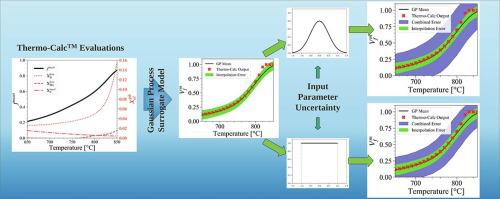当前位置:
X-MOL 学术
›
Comp. Mater. Sci.
›
论文详情
Our official English website, www.x-mol.net, welcomes your
feedback! (Note: you will need to create a separate account there.)
Utilizing Gaussian processes to fit high dimension thermodynamic data that includes estimated variability
Computational Materials Science ( IF 3.1 ) Pub Date : 2021-02-01 , DOI: 10.1016/j.commatsci.2020.110133 Richard Couperthwaite , Douglas Allaire , Raymundo Arróyave
Computational Materials Science ( IF 3.1 ) Pub Date : 2021-02-01 , DOI: 10.1016/j.commatsci.2020.110133 Richard Couperthwaite , Douglas Allaire , Raymundo Arróyave

|
Abstract CALPHAD-based thermodynamic modeling is an integral component of any ICME framework applied to the accelerated development of alloys. The utility of this type of analysis is that it provides knowledge about the impact of chemistry and (to some degree) processing on the phase stability of alloys. This information can later be passed on to other computational tools which can be used to narrow the experimental space that needs to be explored to arrive at optimal alloy designs. Two major challenges arise with these techniques: (1) it is difficult to interface the outputs of such models with other computational tools without significant overhead; (2) CALPHAD-based predictions tend to be agnostic with regards to uncertainty. The latter challenge is because in commercial thermodynamic packages, it is often not possible to access the model parameters as they tend to be encrypted, making the associated thermodynamic databases essentially ‘black boxes’ and so methods that consider only the inputs to the models must be considered. In the current work, we develop surrogate models of CALPHAD-based phase stability predictions that fulfill two objectives: (1) they enable the offline evaluation of a component of the ICME model chain that can then be incorporated into a more complete alloy design scheme without the need to directly interface with a thermodynamic engine; (2) they allow for the consideration of uncertainty. We apply the framework to the investigation of the impact of chemistry and heat treatment on the phase constitution of commercial steel grades and evaluate the performance of this framework relative to direct thermodynamic calculations.
中文翻译:

利用高斯过程拟合包括估计变异性在内的高维热力学数据
摘要 基于 CALPHAD 的热力学建模是任何应用于合金加速开发的 ICME 框架的组成部分。这种类型的分析的效用在于它提供了有关化学和(在某种程度上)加工对合金相稳定性的影响的知识。此信息稍后可以传递到其他计算工具,这些工具可用于缩小需要探索以达到最佳合金设计的实验空间。这些技术带来了两个主要挑战:(1) 很难在没有显着开销的情况下将此类模型的输出与其他计算工具连接起来;(2) 基于 CALPHAD 的预测在不确定性方面往往是不可知的。后一个挑战是因为在商业热力学包装中,通常无法访问模型参数,因为它们往往是加密的,这使得相关的热力学数据库本质上是“黑匣子”,因此必须考虑仅考虑模型输入的方法。在当前的工作中,我们开发了基于 CALPHAD 的相稳定性预测的替代模型,该模型实现了两个目标:(1)它们能够对 ICME 模型链的一个组件进行离线评估,然后可以将其合并到更完整的合金设计方案中,而无需需要直接与热力学引擎连接;(2) 它们允许考虑不确定性。
更新日期:2021-02-01
中文翻译:

利用高斯过程拟合包括估计变异性在内的高维热力学数据
摘要 基于 CALPHAD 的热力学建模是任何应用于合金加速开发的 ICME 框架的组成部分。这种类型的分析的效用在于它提供了有关化学和(在某种程度上)加工对合金相稳定性的影响的知识。此信息稍后可以传递到其他计算工具,这些工具可用于缩小需要探索以达到最佳合金设计的实验空间。这些技术带来了两个主要挑战:(1) 很难在没有显着开销的情况下将此类模型的输出与其他计算工具连接起来;(2) 基于 CALPHAD 的预测在不确定性方面往往是不可知的。后一个挑战是因为在商业热力学包装中,通常无法访问模型参数,因为它们往往是加密的,这使得相关的热力学数据库本质上是“黑匣子”,因此必须考虑仅考虑模型输入的方法。在当前的工作中,我们开发了基于 CALPHAD 的相稳定性预测的替代模型,该模型实现了两个目标:(1)它们能够对 ICME 模型链的一个组件进行离线评估,然后可以将其合并到更完整的合金设计方案中,而无需需要直接与热力学引擎连接;(2) 它们允许考虑不确定性。









































 京公网安备 11010802027423号
京公网安备 11010802027423号